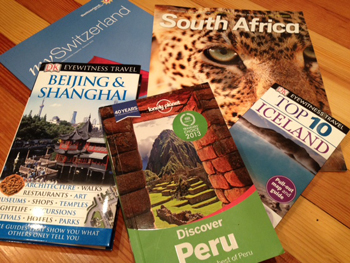The Secret To Seeing It All
Your Five-Year Travel Plan
By Susan Farewell

Aida Tours, Cappadocia, Turkey
Do you have travel regrets? Did you take your whole family to Paris to discover that your 4 year old could care less about museums? Did you miss taking your kids to the Grand Canyon and now they’re out of the nest? Did you spend too much money on your Colorado ski trip because you waited until the last minute to book it?
Travel mistakes can be costly—not just monetarily, but in terms of the lost time and the fact that you may not have the opportunities again. No matter what your age, travel time is precious and should not be left to happenstance.
I've been helping clients manage their travel portfolios and I've found the most effective tool is a Five-Year Travel Plan which helps maximize their travel time and money.
Here are some of the steps I take to help individuals, couples and families realize their collective travel dreams.
Step One: Write a Family Travel Mission Statement. The first thing I do is sit down with all the members of a family and identify what it is they are looking for in travel. Is it for the education? To relax? For multi-cultural experiences? I help them define how big a priority travel is in the life of their family. Is there something else they are focused on (i.e. renovating the house or taking care of an elderly parent ) and travel is just an occasional treat or are they trying to get to every continent before the kids go to college?
Step Two: Develop a Travel Wish List. Whether an individual traveler, a growing family, or a retired couple, it’s important to list the places you want to go.  I always encourage my clients to have fun with this step. Think about the places you’ve always thought about visiting but also let yourself fantasize. Oftentimes, putting it in writing translates into making it happen. I always encourage my clients to have fun with this step. Think about the places you’ve always thought about visiting but also let yourself fantasize. Oftentimes, putting it in writing translates into making it happen.
Step Three. Work up a Travel Budget. While it may be impossible to know from one year to the next how much one can afford to spend on travel, it’s important to do at least a rough budget looking ahead five years. Once there are ballpark numbers, I am able to guide clients as to the various options they can consider. This often requires some creative thinking. For example, just because a family safari is expensive doesn’t mean it’s out of the question. It might just mean taking short road trips instead of major vacations one year or skipping the expensive ski trip another.
Step Four. Identify Time Constraints. School calendars. Work schedules. Sport commitments. Most people already know they have limited time to travel. But there are other time constraints that play a role in decision making such as the seasons and weather in the destinations you might be interested in. Sure, you may have the extra time to travel to Japan in the summer, but do you really want to be there when it’s in the 90s? And sometimes the season/weather costs a great deal more. For example, renting a villa in the Caribbean can be three times as expensive Christmas week as it is the rest of the year.
Step 5. Analyze Age/Interest Differences. While your 8-year-old son might be itching to go to Colonial Williamsburg, your 14-year-old has her eyes on Paris. It’s important to please everyone on every trip.
Sometimes this can very simply be accomplished by waiting a year or two. Or choosing a destination that has something for everyone.
Step 6. Determine How Active To Be. While you and your husband might be runners and think nothing of hiking in the Alps, your tweens may want to have nothing to do with that kind of exertion. But…wait…that doesn’t mean you can’t do the trip. What about hiking to an alpine adventure center where the kids can shoot down the mountain on a summer toboggan or a mountain bike?
Step 7. Plan Second Honeymoon and Other Getaways as well as Family Trips. While it’s easy to get caught up in the family travel planning, don’t lose sight of the importance of setting aside romantic weekends away with your spouse, or seizing opportunities to go off solo or with college classmates (think girlfriend getaways, guys bonding trips...).
Step 8. Write it all down. My experience says planning five years out (weekends, holidays, vacations) is the most effective way to make sure you go where you want to go. Once you commit it to a document, you are already on your way.
.
Step 9. Commit, but Be Flexible. While I think it’s important to have Five-Year Travel Plans, I think it’s also important to be flexible with them. Oftentimes I come back from trips with a whole new list of places I want to go next.
Step 10. Revisit the Five-Year Plan Annually. Once I’ve prepared a Five-Year Travel Plan for a client, I recommend reviewing it at least once a year or in the event something changes (better job or lost job; new baby…what have you).
Lastly, don't hesitate to seek out professional guidance. You use a financial professional to plan your financial future. Having a travel professional oversee your travel portfolio can not only save you money but also save you from having many travel regrets. Perhaps the most valuable take-away, however, is the time a travel professional can save you. Those of us in the field live, think and breathe travel. We can guide you to the best safari lodges and boutique hotels. We know when you should visit Morocco and where you should stay. We know which restaurant in Lausanne you absolutely have to go to. But most importantly, we can guide you in making sure you visit all the places on your list.
With all this kind of foresight and preparation, you won't find yourselves looking back someday saying "Why didn't we go there?".
|

